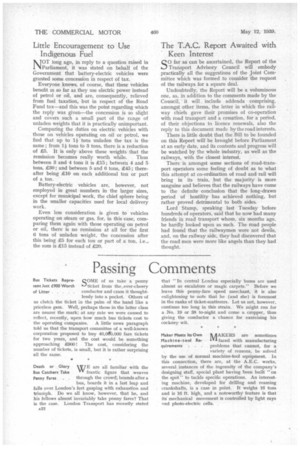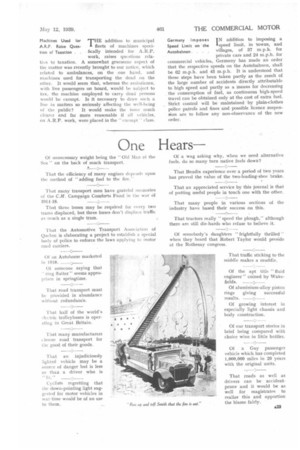Passing Comments
Page 24

Page 25

If you've noticed an error in this article please click here to report it so we can fix it.
Bus Tickets ReprequviE of us take a penny sent Just £900 Worth Liticket from the ever-cheery
of Litter conductor and cram it thought lessly into a pocket. Others of us clutch the ticket in the palm of the hand like a priceless gem. Well, perhaps those in the latter class are nearer the mark; at any rate we were caused to reflect, recently, upon how much bus tickets cost to the operating companies. A little news paragraph told us that the transport committee of a well-known corporation proposed to buy 40,040,000 fare tickets for two years, and the cost would be something approaching 2000! The cost, considering the number of tickets, is small, but it is rather surprising all the same.
Death or Glory NIUE are all familiar with the
Bus Catchers Take YY frantic figure that weaves Penny Fares . • through the crowd, bounds after a bus, boards it in a last leap and falls over London's feet gasping with exhaustion and triurnph. Do we all know, however, that he, and his fellows almost invariably take penny fares? That is the case. London Transport has recently stated 1.22 that "In central London especially buses are used almost as escalators or magic carpets." Before we leave this penny-fare speed merchant, it is also enlightening to note that he (and she) is foremost in the ranks of ticket-scatterers. Let us not, however, continue too long in this strain. We might run for a No. 10 or 38 to-night and come a cropper, thus giving the conductor a chance for exercising his cockney wit.
Maker Meets Its Own MAKERS are sometimes Ma chine-tool Re
IV' faced with manufacturing
quirements . problems that cannot, for a
variety of reasons, be solved by the use of normal machine-tool equipment. In this connection, there are, at the A.E.C. works, several instances of the ingenuity of the company's designing staff, special plant having been built "on the spot" to tackle specific operations. An interesting machine, developed for drilling and reaming crankshafts, is a case in point. It weighs 16 tons and is 16 ft. high, and a noteworthy feature is that its mechanical movement is controlled by light rays and photo-electric cells. Machines Used for A.R.P. Raise Question of Taxation .
THE addition to municipal fleets of machines specifically intended for A.R.P. work, raises questions relative to taxation. A somewhat gruesome aspect of the matter was recently brought to our notice, which related to ambulances, on the one hand, and machines used for transporting the dead on the other. It would seem that, whereas the ambulance, with live passengers on board, would be subject to tax, the machine employed to carry dead persons would be exempt. Is it necessary to draw such a line in matters so seriously affecting the well-being of the public? It would make the issue much clearer and far more reasonable if all vehicles, on A.R.P. work, were placed in the " exempt " class.
Germany Imposes IN addition to imposing a Speed Limit on the Aspeed limit, in towns, and Autobahnen. . . . villages, of 37 m.p.h. for private cars and 24 m.p.h. for commercial vehicles, Germany has made an order that the respective speeds on the Autobahnen, shall be 62 m.p.h. and 43 m.p.h. It is understood that these steps have been taken partly as the result of the large number of accidents directly attributable to high speed and partly as a means for decreasing the consumption of fuel, as continuous high-speed travel can be obtained only at the cost of extra fuel. Strict control will be maintained by plain-clothes police patrols and fines and possible licence suspension are to follow any non-observance of the new order.














































































